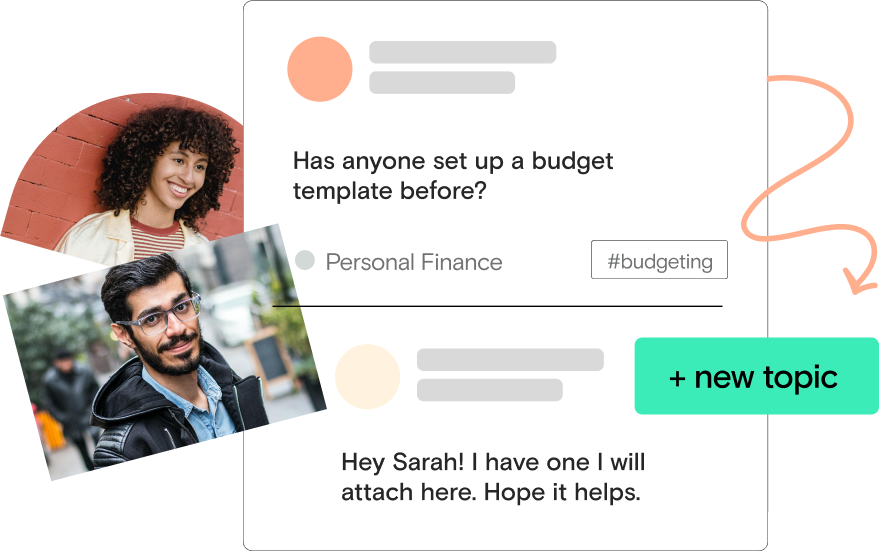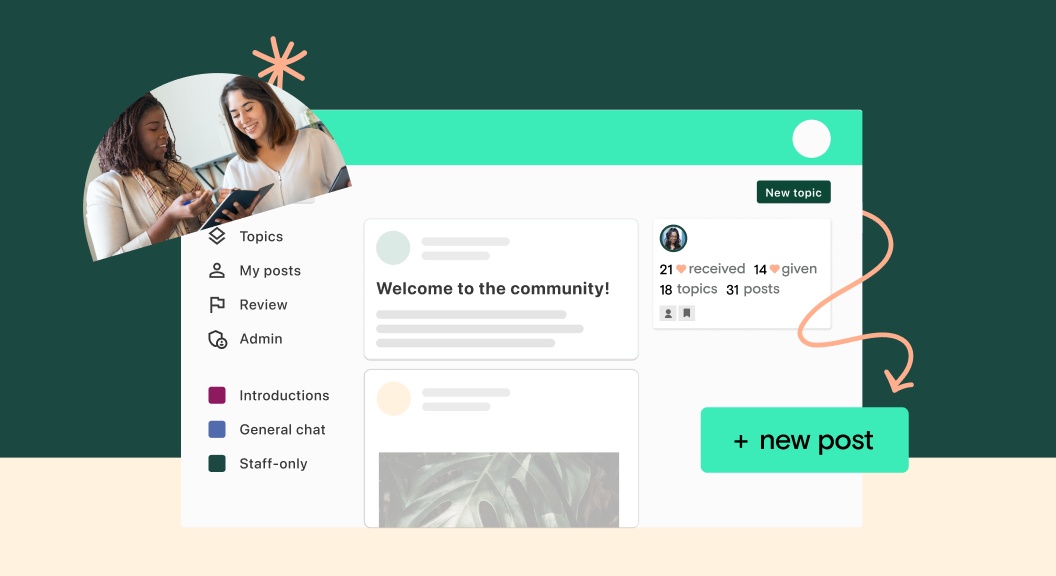There are many different types of online communities to consider to support your business. We believe in the value of community so much at Teachable that we just launched an online community option to incorporate into your business. And established companies like Atlassian, Salesforce, and ConvertKit have long invested in popular online communities, too.
While online communities supporting businesses are hardly new, in recent years, factors like cultural fatigue from traditional broadcast marketing, more businesses focused on mirco-niches, and yes, a global pandemic, have ushered in a renewed focus on building online communities for brands big and small. Especially in the creator economy space, communities have gone from a nice-to-have add on to a central part of many businesses.
That’s exactly why we’ve built a new way to create meaningful connections between your students (and them with you) with our community product. Now you can build an online community for your students alongside your courses, coaching, digital downloads, and memberships and support your business in a brand new way.

A community for all
Communities show up in a number of different ways. And each can be different depending on the outcome, audience, and goal. One might look like professional communities that connect people by industry or offer networking opportunities. One could also be a social community to encourage connection and widen social networks. Meanwhile, a customer community or brand community unites people through a shared emotional connection to a brand identity.
Creating a community keeps your audience engaged in between launches. It offers a sounding board for testing new ideas and offerings and adds value to existing offerings by helping your students find solutions with community leaders or members.
Creating a sense of community can be achieved within social media platforms by starting a group and posting engaging content. Before you create a community, it’s essential to find the right community platform that works for you and is accessible for your students.
Because of the potential size and breadth of a new community project, for creators considering starting one, it’s helpful to choose a specific strategy you can rely on to maintain focus and optimize your results. Here, we’ll be walking you through four different types of online communities that are effective for business owners operating in the creator economy space.
Online communities: From buzz-word to big reward
Before we dive into strategies, let’s establish some common language. Community can mean a lot of things. We can use it to talk about our neighborhood, our hobbies or common interests, and our identities. Brands use this word in multiple ways, too—especially lately, as it’s become a buzzier topic.
Sometimes when brands talk about “their community,” they’re talking about something concrete, and sometimes they’re referring to their audience more broadly. Neither is exactly right nor wrong (and there’s a lot that’s already been said on this topic), but for now, let’s just say: When we talk about communities, we’re talking about a concrete space you create for your members to interact with each other. (If you’re interested in digging deeper into this topic, The Community Club’s Capital C Framework for communities is helpful).
Getting specific about language is important not because it draws lines around what is and isn’t a “real” community, but because it lets us choose the right strategies to suit our use case. But, getting tactical enables us to measure things. Measuring things allows us to optimize our efforts. And optimizing our efforts is what ultimately yields rewards.
Different types of communities
In the community world, experts break down different types of communities in a couple of ways. First, they look at if a community enhances a product (i.e., community members get access by being a customer or audience member) or if a community is the product (i.e., customers pay to access the community, and it’s where the core value lives).
Next, they often look at purpose—what communities offer. A popular way to break this down is to compare a support or product community (i.e., a place where members can ask an expert questions) to a community of practice (i.e., a place where members build skills together).
For the creator economy space, most communities are going to be a variation on the community as a product model. They’ll become a part of your core offering—a part of the value you charge for when you sell information. Similarly, most creator economy communities will also be communities of practice. We’ll dive a bit deeper into the different types of online communities than these two dichotomies to give you four examples of some of the most popular kinds of community within the space.
Communities that let students practice skills and get feedback
Many creators report that while students join their courses with the best of intentions to learn a new skill, it can be challenging to maintain the dedication to actually practice. What’s more, even with the best instructional content, students can sometimes get stuck and need personalized feedback to progress.
This poses a couple of challenges for course creators. First, because feedback requires personalized attention to a unique problem versus broad advice on common problems, it’s really hard to scale. This type of community structure—one that’s optimized to allow students to practice skills and get feedback from one another—can address this challenge.
Second, many business owners find they’re able to build a more sustainable business when they build multiple things for the same small group of people (like an introductory course and then a more advanced course) versus relying on bringing in new customers in order to grow.
With a community of feedback and practice, you can ensure that your students are successful enough that they’re primed to continue learning. Try bringing in other experts in your focus area for feedback residencies or set up a mentorship program to connect advanced students with beginners.
Who it’s for:
- Creators who teach physical or creative skills (like art, music, or writing) that are usually developed through practice in social settings
- Those who want to create and sell multiple “levels” of courses to a small audience
- Creators who want to scale “feedback” as they grow
Who’s doing it well:
- Tomlin Leckie of tomlinharmonicalessons.com
- No-code product development community Makerpad (This is an example of community as standalone product—they were recently acquired by automations tool Zapier.)
What to measure: Look for increased course completions and repeat purchases from the same customers at multiple levels
Communities that give real-time structure to a self-paced experience
Suppose you have a really awesome, evergreen course. But, you find students simply have a better experience going through it (and are more likely to finish) when you help hold them accountable.
Building a community element into your course is a great way to instantly transform it from a self-paced, evergreen course to a cohort-based-course.
Try simple things like posting progress checks-in the community, doing an end-of-week live Q&A, or starting feedback threads for independent work to add a sense of structure to an otherwise pre-recorded course.
As a bonus: Cohort-based courses have a higher perceived price point than do self-paced courses, so this is a great opportunity to update your prices accordingly.
Who it’s for:
- Creators who want to raise the value of an existing evergreen course
- Creators who want to increase the likelihood their students will finish courses
Who’s doing it well:
- Marie Forleo’s B School
- Tiago Forte’s Building a Second Brain
What to measure: Increased course completions; the ability to charge at a higher price point. Note: We recommend doing some user research before launching your new price to hone in on perceived value by adding a community.
Communities that let you access an expert
While some of the previous community examples we looked at may be beneficial for a creator’s entire student base, some creators also use communities as a way to create exclusive, “inner circle” access to a specific expert. This is especially true for businesses that center around a specific person more than a specific subject matter.
In these scenarios, creators may be looking to scale their ability to have close relationships with students, while still maintaining community as a top tier, exclusive offering that expands possible price points above and beyond what’s possible for a single, standalone course purchase. Try running mastermind calls or other real-time offerings that expand access to the expert.
Who it’s for:
- Consultants or any creators whose main value prop is direct access to their expertise
- Creators who are interested in offering multiple access tiers or adding community as a private, exclusive-access add-on to a course
Who’s doing it well:
- The Smart Passive Income (SPI) Community
What to measure: Conversions to a higher access tier; monthly recurring revenue between stand-alone course purchases (if using a subscription model)
Communities that add value between launches
There’s no feeling like running a successful launch for a new course or product. Especially for full-time creators relying on course sales as a stable course of income, the launch paradigm can make it hard to predict your income between launches. But, that doesn’t mean you have nothing to offer your students in between major new course launches.
Some creators use an additional subscription to their community to continuously provide value to their students in between major drops of new content—and to provide themselves with a steadier source of income.
Try using your community as a testing ground for new content as you develop your next big product. Monthly workshops, exclusive guides, or challenges are great content styles to test out.
Who it’s for:
- Those looking to create a more stable source of income in between major launches
- Creators who are trying to transition from just one or two courses to a membership or marketplace model with lots of courses
- Creators who want a place to test and validate content before devoting time to developing a whole course
Who’s doing it well:
- Watercolor instructor Angela Fehr
What to measure: Monthly recurring revenue, the effectiveness and popularity of content you launch in community as you develop new courses
And as always remember: A strong community strategy can help take your online course business to new heights.

FAQs
What are examples of online communities?
Some examples of online communities include a professional community that connects people by industry and/or offers networking opportunities; a social community to encourage connection and widen social networks; and a customer community or brand community that unites people through a shared emotional connection to a brand identity.
What are the best online communities?
The best online communities help their members find solutions and meet the needs of the community. Communities add value to your existing offerings, while keeping your audience engaged in between launches.
How do you find online communities?
While online communities supporting businesses are hardly new, in recent years, factors like cultural fatigue from traditional broadcast marketing, more businesses focused on mirco-niches, and yes, a global pandemic, have ushered in a renewed focus on building online communities for brands big and small. Especially in the creator economy space, communities have gone from a nice-to-have add on to a central part of many businesses. This means you can find them on social media, hosted by some of your favorite brands or leaders, professional associations, and more.
Want more on community? Whatever model you do choose, if you’re looking to create a customized community launch framework (everything from choosing software to activating your members), Noele has got you covered there, too. Her lean community launch framework is a great way to strategize for a new community, even if you have a small team—or even a team of one.
Join more than 150,000 creators who use Teachable to make a real impact and earn a real income.


.png)

.png)
.png)


